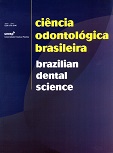Avaliação do Ph de várias substâncias utilizadas no clareamento intracoronário
DOI:
https://doi.org/10.14295/bds.2007.v10i3.289Abstract
O objetivo desta pesquisa foi avaliar, in vitro, dentro de um período de 7 dias, os valores do pH de 4 substâncias utilizadas no clareamento intracoronário. O pH foi avaliado em cinco amostras (quatro soluções clareadoras e uma solução controle). As amostras de cada grupo foram assim constituídas: a) Grupo 1: 15ml de água destilada; b) Grupo 2: 10g de perborato de sódio (Byofórmula – Farmácia de manipulação) com 5ml de água destilada; c) Grupo 3: 10g de perborato de sódio com 5ml de peróxido de carbamida 10% (Byofórmula – Farmácia de manipulação); d) Grupo 4: 10g de perborato de sódio com 5ml de peróxido de hidrogênio 30% (Byofórmula – Farmácia de manipulação); e) Grupo 5: 15ml de peróxido de hidrogênio 30%. Os materiais foram acondicionados em frascos plásticos (FujiFilm) e o valor do pH foi estabelecido com um aparelho pH-metro (Digimed DM-20), logo após a manipulação e também após 1h, 24h e 7 dias. Os resultados mostraram que os valores do pH das associações do perborato de sódio mantiveram-se praticamente constantes, com exceção da associação com o peróxido de hidrogênio, onde ocorreu um aumento gradativo do pH no decorrer dos períodos avaliados. O pH do peróxido de hidrogênio também apresentou-se constante, mantendo-se ácido durante todo o experimento. Das quatro soluções analisadas, apenas o peróxido de hidrogênio apresentou um pH ácido, que assim se manteve em todos os períodos avaliados.Downloads
Downloads
Published
How to Cite
Issue
Section
License
Brazilian Dental Science uses the Creative Commons (CC-BY 4.0) license, thus preserving the integrity of articles in an open access environment. The journal allows the author to retain publishing rights without restrictions.
=================




























